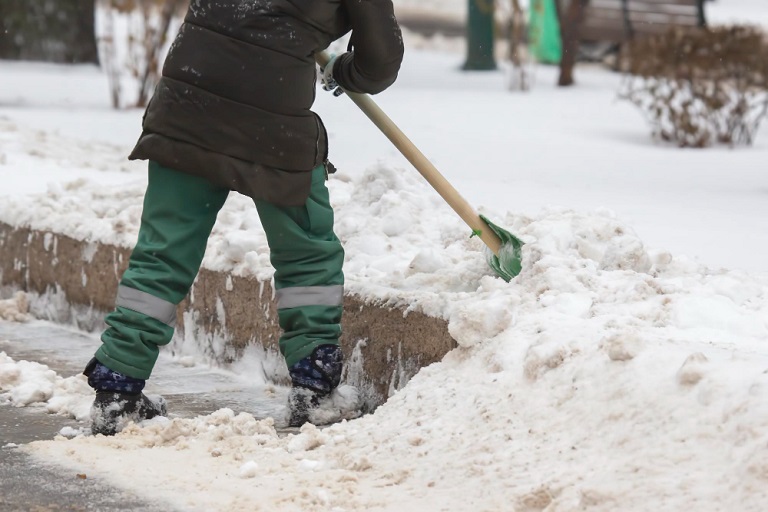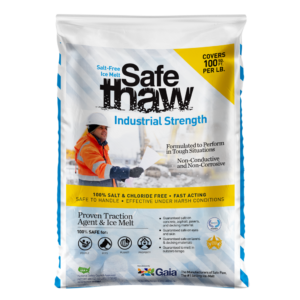Difference Between Sand, Kitty Litter And Walk On Ice

As homeowners, we shovel fresh snow after a snowstorm and salt on our walkways. It may appear to be the most excellent technique to remove slick ice surfaces. However, we overlook the terrible implications of using poisonous rock salt. So, what should we do to safely walk on ice?
The solution is to use an effective traction agent free of chemicals. It can provide immediate traction instead of conventional ice melts, which take hours to function. This article looks at several ecologically friendly traction agents that are effective and don’t affect your surroundings or pets.
How To Safely Walk On Ice Using Traction Agents?
A traction agent is not an ice melt. Instead, it improves friction on the ice layer, preventing any unpleasant mishaps. Good traction agents absorb surplus water on the ice layer and give a sandpaper-like effect by strengthening your shoes’ grip on the slippery ice layer. When it comes to purchasing traction agents, you have several options. Different types of traction agents
Here Is The List Of Some Commonly Used Traction Agents
Walk On Ice
The effect of Walk On Ice is two-fold. First, it absorbs surplus slippery water on the ice surface. Then the grippers latch themselves to the ice to provide traction. Unlike other traction agents, it does not harm your property, including harmful chemicals and corrosive salts that can demolish concrete structures, parking lots, and driveways.
This product combines natural volcanic rock and seven other minerals that are safe and reusable. Its absorbers absorb the liquid on the ice, making it less slippery. The grippers then employ their gripping ability to cling to the ice. As a result, you will have a stable surface to walk on.
Moreover, it comes in an easy carry disposable can. You can keep it in your handbag or gloves compartment and use it whenever you meet the treacherous icy surface. It can also be rubbed on your vehicle’s tires to ensure safe driving while going on snow-covered roads.
Get ready for winter with Walk On Ice instant traction on snow and ice
Sand
Sand is another frequent traction agent. It is, however, ineffective and only works for a limited period. Furthermore, sand may be exceedingly nasty since it condenses into a sludge that clogs storm drains and contaminates water.
Kitty Litter
Kitty litter is made out of clay granules that absorb moisture. When wet, kitty litter, on the other hand, turns sticky. When the ice melts, it leaves behind sticky clay lumps that are difficult to clean.
Choosing a Safe Anti Skid Ice Melt for Daily Use
As snow and freezing temperatures roll in, homeowners scramble for ways to maintain safe footing on slippery surfaces. The common instinct is to reach for salt, but this quick fix can have lasting consequences on concrete, water systems, and even your pets. A better alternative is using an anti skid ice melt—a product that improves traction without relying on chemical melting. Rather than waiting for salts to dissolve ice, traction agents offer immediate grip.
But here’s the twist—not all traction agents are created equal. While some improve stability, others cause more mess than safety. From sand to kitty litter to modern solutions like Walk On Ice, knowing the difference helps you stay ahead of winter hazards, including the often invisible and dangerous black ice on roads.
Black ice, by the way, forms when rain or melted snow refreezes on cold pavement. It’s nearly impossible to detect and can linger for hours depending on the temperature and sun exposure. And while you can drive on black ice, it’s risky—especially if you don’t use traction aids or chains. Wondering do chains help with black ice or how long does it take black ice to melt? Yes, to some extent. But for daily use, lightweight anti skid solutions like Walk On Ice offer more flexibility.
Comparing Anti Skid Ice Melt Options: Sand, Kitty Litter, and Walk On Ice
Let’s break down the most talked-about options like can you drive on black ice:
Walk On Ice
This natural traction agent is a game-changer. Made with volcanic rock and other naturally sourced minerals, it offers dual action: it first absorbs the watery layer that makes ice slick and then uses its “grippers” to bite into the surface. The result? Immediate traction, even on black ice, with no environmental side effects. It’s OSHA-compliant, pet-safe, and fits in a purse or glove compartment for easy access.
Sand
While sand does increase traction, it lacks staying power. Over time, it settles into sludge, blocks drains, and pollutes runoff water. It’s better than nothing—but it’s messy and far from ideal as an anti skid ice melt.
Kitty Litter
At first glance, kitty litter might seem like a clever alternative. It absorbs moisture—but once it gets wet, it turns into sticky clay that’s difficult to clean and becomes a slip hazard in itself. It also doesn’t provide much actual grip once snow or ice begins to melt.
Conclusion
So, can you rely on salt this winter? You could—but your concrete, pets, and plants would pay the price. Can chains help with black ice? Somewhat, but they’re not a practical solution for every trip to the store. Instead, choose a chemical-free anti skid ice melt like Walk On Ice. It delivers fast, clean, and eco-safe traction whether you’re walking across your driveway or navigating black ice under your tires. Unlike kitty litter or sand, there’s no mess, no pollution, and no waiting. Stay safe, stay upright, and walk confidently with ice Traction Magic—no matter what winter throws your way.
Other Ice Melt Products
Safe Paw
The Original and #1 Selling Pet and Child Safe Ice Melt for over 20 years. Guaranteed environmentally safe – will not harm waterways and sensitive wetlands. All products are made in the USA.

Safe Thaw
Imagine an ice melt you can put down and never worry about. It won’t harm pets, kids, and your property. That’s Safe Thaw. Unlike anything else on the market, Safe Thaw can change how winter affects our planet.



